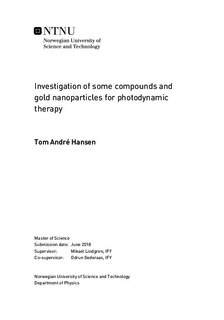Investigation of some compounds and gold nanoparticles for photodynamic therapy
Master thesis
Permanent lenke
http://hdl.handle.net/11250/2565891Utgivelsesdato
2018Metadata
Vis full innførselSamlinger
- Institutt for fysikk [2686]
Sammendrag
In this thesis several chemical compounds for possible use as photosensitizers (PS) in photodynamic therapy (PDT) have been investigated. First a photophysical characterization was performed using different spectroscopic techniques. With these methods the absorption, fluorescence, fluorescence lifetime and quantum yield, triplet excited state absorption and singlet oxygen luminescence, were quantified. Furthermore, experiments using cancer cell models were carried out to investigate possible compounds for PDT. The compounds which have been characterized can be divided into two groups; three different protoporphyrins and three dye compounds, all known to produce singlet oxygen. Among the protoporphyrins, Protoporphyrin A showed higher absorption, fluorescence and singlet oxygen production and lifetime compared to Protoporphyrin B and Protoporphyrin IX. Comparing the three singlet oxygen producing compounds, both eosin B and perinaphtenone showed very weak fluorescence, while erythrosin B had a much stronger fluorescence. Perinaphtenone yielded a better singlet oxygen production and longer singlet oxygen lifetime while eosin B showed no singlet oxygen luminescence.
The cell lines AY27 (cancer from rat bladder) and WiDr (cancer from human colon) were used in PDT experiments. The WiDr cells were used in photobleaching experiments containing cells treated with Protoporphyrin A or Protoporphyrin B. The exposure time of blue light (412 nm) ranged from no light up to 600 seconds. An investigation of the addition of gold nanoparticles to erothrysin B, in order to enhance the effect of PDT, was performed after initial photophysical characterization. The toxicity of gold nanoparticles were determined by checking the cell viability with the use of a MTT-assay. The results from this assay were studied to obtain a concentration of gold nanoparticles which were added to erythrosin B incombination by light treatment (532 nm) of AY27 cells. This yielded no significant difference between cells treated with an addition of gold nanoparticles, as opposed to those without.
